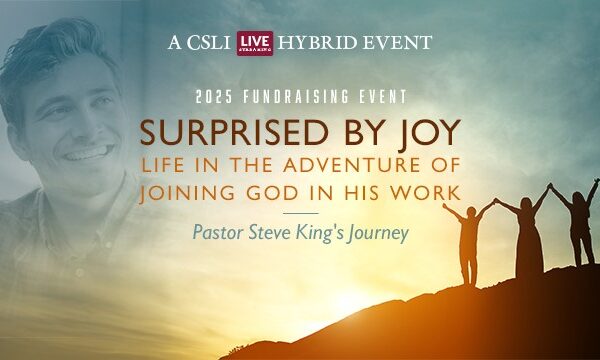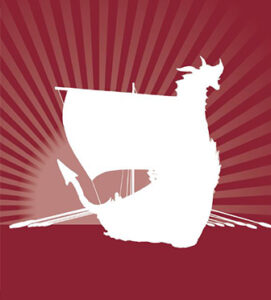Back to series
Biblical Truths in C.S. Lewis’s


Biblical Truths in C.S. Lewis’s
The Chronicles of Narnia
VOLUME 8 NUMBER 1 ISSUE OF BROADCAST TALKS (PDF)
BROADCAST TALKS presents ideas to cultivate Christ-like thinking and living. Each issue features a transcription of a talk presented at an event of the C.S. Lewis Institute.
The following is adapted from a talk given by Christin Ditchfield on May 6, 2022, at a C.S. Lewis Institute livestream event titled, Biblical Truths in C.S. Lewis's The Chronicles of Narnia.
I’m just delighted to be here to share with you this evening as we talk about those biblical truths that can be found in The Chronicles of Narnia.
It began with a book called The Lion, the Witch, and the Wardrobe, and that’s all C.S. Lewis thought it was going to be, this one story that just wouldn’t let go of him, and he had to write. He wrote it. He thought he was done, but very quickly the response was tremendous. People loved this world that he had envisioned and created. They loved the characters they met in this world. And Lewis found his brain spinning with more ideas and more images and more stories to tell. So it became the seven-book series. It’s been printed . . . I guess more than 100 million copies are in print in dozens of languages. There have been numerous film versions, animated and movie versions even more recently. I think there’s a new Netflix series coming out. There have been all kinds of comic book versions and illustrated versions and radio theater. You name it, you can find a way to engage in this story and learn a little bit about this wonderful world of Narnia.
But even when the books were first published, one at a time, back in the fifties, there were some misunderstandings about the stories and about what Lewis was trying to do. There were some people then, as now, who insist that there’s nothing really Christian about these books. There’s nothing very spiritual. You just see that because you want to. Yeah, Christians like to read symbolism into everything, right? There are people who claim it doesn’t have any spiritual significance.
On the other hand, there are people who’ve gone a little overboard trying to figure out exactly what Lewis might have been thinking. They claim that he had this whole agenda; this is what he meant for this spiritual truth and this one. They describe his process in a way that is totally off base.
How It Did and How It Didn’t Happen

Lewis himself addressed these approaches, these misunderstandings. So before we talk a little more specifically about the spiritual themes in The Chronicles of Narnia, I want you to hear, right from Lewis, how it did and didn’t happen, where his inspiration came, and where it didn’t come from. In an essay called “Sometimes Fairy Stories May Say Best What’s to Be Said,” Lewis wrote,
Some people seem to think that I began by asking myself how I could say something about Christianity to children; then fixed on the fairy tale as an instrument; then collected information about child-psychology and decided what age-group I’d write for; then drew up a list of basic Christian truths and hammered out “allegories” to embody them. This is all pure moonshine. I couldn’t write in that way at all. Everything began with images; a faun carrying an umbrella, a queen on a sledge, a magnificent lion. At first there wasn’t even anything Christian about them; that element pushed itself in of its own accord.
In a paper titled “It All Began with a Picture . . .” Lewis said, “suddenly Aslan came bounding into it . . . I don’t know where the Lion came from or why He came. But once He was there, He pulled the whole story together.”
Lewis said in a letter, Aslan “is an invention giving an imaginary answer to the question, ‘What might Christ become like if there really were a world like Narnia and He chose to be incarnate and die and rise again in that world as He actually has done in ours?’” Lewis called that a supposal. Imagine if Jesus were to go to another world and die and rise again in that world. What would it look like?
In his essay [on fairy tales], Lewis stated further,
I wrote fairy tales because the Fairy Tale seemed the ideal Form for the stuff I had to say . . .
I thought I saw how stories of this kind could steal past a certain inhibition which had paralysed much of my own religion in childhood. Why did one find it so hard to feel as one was told one ought to feel about God or about the sufferings of Christ? I thought the chief reason was that one was told one ought to. An obligation to feel can freeze feelings . . . But supposing that by casting all these things into an imaginary world, stripping them of their stained-glass and Sunday school associations, one could make them for the first time appear in their real potency? Could one not thus steal past those watchful dragons? I thought one could.
Well, even though he talked about catching the readers unaware, stealing past the watchful dragons, and smuggling theology in, Lewis was adamant that The Chronicles of Narnia are not allegories, though many people have described them as such, and, technically speaking, this is true. You want to remember that Lewis was a literature professor, and he used the word allegory in the strictest, most accurate sense, right? In an allegory, every character or event or scene is a symbol. There’s a one-to-one ratio. It’s a symbol of something else, and it’s consistently that symbol all the way through.
Now, there are many different forms of allegory, but the one I always like to think of, because many of us are familiar with it, and it’s the most obvious allegory out there, is The Pilgrim’s Progress, a book written in the 1600s. Remember, it’s a story about a man named Christian who is a Christian who goes on a journey to the Celestial City, which is the heavenly city; throughout the journey, he encounters many people, like the giant Despair, who represents Despair, and he encounters a faithful friend named Faithful, right? That’s a very obvious and overt allegory. Still incredibly powerful, but that’s traditionally an allegory. The giant Despair is a representation of the despair that we all battle in life, right?
Lewis’s stories are not like that at all, and some of the characters and scenes and things that take place in Narnia don’t have any particular spiritual significance. Maybe they come from Greek or Roman mythology, or maybe they come from some other literature that Lewis had read or from his own imagination. They may or may not have any spiritual truth for us. But many of the characters do have spiritual significance. They come from the spiritual realm. Although Lewis didn’t start out originally to write stories that would illustrate the most vital truths of the Christian faith, that is essentially what he did.
Biblical Truths in Every Chapter
Jesus said, in Matthew 12:34, “… out of the abundance of the heart the mouth speaks” (NRSV). In other words, what’s in our heart is what comes out. Consciously, and I think at times even unconsciously, Lewis wound powerful biblical truths through every chapter of The Chronicles of Narnia. His deeply rooted faith naturally found its expression in everything that he wrote. And he acknowledged this in The Voyage of the Dawn Treader. At the end of the book, the great lion Aslan tells the two Pevensie children, who we met in The Lion, the Witch, and the Wardrobe, that their adventures in Narnia have come to an end. They will not be returning to this country again. And Edmund and Lucy are horribly upset. “‘It isn’t Narnia,’ you know, sobbed Lucy. ‘It’s you. We shan’t meet you there. And how can we live, never meeting you?’” In their time in Narnia, they’ve grown deeply attached to Aslan. They have come to love him and serve him, and they can’t think of life without him.
“You shall meet me, dear one,” said Aslan.
“Are—are you there, too, Sir?” said Edmund.
“I am,” said Aslan. “But there I have another name. You must learn to know me by that name. This was the very reason that you were brought to Narnia, that by knowing me here for a little, you may know me better there.”
Years ago, after reading this passage in Dawn Treader, a little girl named Hila wrote to Lewis, asking him, what is Aslan’s other name? Ever the teacher, Lewis responded, “Well I want you to guess. Has there never been anyone in this world who (1.) Arrived at the same time as Father Christmas. (2.) Said he was the son of the Great Emperor. (3.) Gave himself for someone else’s fault to be jeered at and killed by wicked people. (4.) Came to life again. (5.) Is sometimes spoken of as a Lamb.” He appears as a lamb at the end of Dawn Treader. “Don’t you really know His name in this world. Think it over and let me know your answer!” 
Well, just as Edmund and Lucy’s adventures in Narnia helped them to come to know Aslan—Jesus—so much better, our adventures in Narnia can do the same for us. Millions of us have met Aslan in The Chronicles of Narnia and then learned to know him so much better in our world by his other name.
Although in one case, it did actually cause a crisis of faith. There was one little boy who really struggled with his experience in the Chronicles, and his mother wrote a letter to Lewis back in the day. Lewis wrote hundreds of letters, received hundreds of letters, answered every letter he received. In fact, if I had to name one of my top-ten Lewis books, it would be a compilation of his letters called Letters to Children. They’re amazingly witty and tender and clever, and he wrote back to this one mother. She told Lewis that her little boy, Laurence, loved The Chronicles of Narnia and loved Aslan so much that he was afraid that he’d become an idol worshiper because you’re not supposed to love anybody other than Jesus, right? Well, Lewis got the letter from his publisher, and he wrote her back the most beautiful letter, and here again, listen for Lewis telling us, acknowledging the spiritual truth that found its way into the Chronicles. Listen to him telling us, yeah, it’s there, and it’s there for a reason, and it’s okay. Enjoy it.
All right, here he says,
Dear Mrs. K…,
1/ Even if he was loving Aslan more than Jesus (I’ll explain in a moment why he can’t really be doing this) he would not be an idol-worshipper. If he was an idol-worshipper, he’d be doing it on purpose, whereas he’s now doing it because he can’t help doing it, and trying hard not to do it. But God knows quite well how hard we find it to love Him more than anyone or anything else, and He won’t be angry with us as long as we’re trying. And He will help us.
2/ But Laurence can’t really love Aslan more than Jesus, even if he feels that’s what he’s doing. For the things he loves Aslan for doing or saying are simply things that Jesus really did and said. So that when Laurence thinks he’s loving Aslan, he is really loving Jesus: and perhaps loving Him more than he ever did before.
Lewis goes on to address how little boys’ imaginations are captured by the idea of a lion, and that might be easier for him to relate to, and that that’s only natural. “God knows all about the way a little boy’s imagination works (He made it, after all) and knows that at a certain age the idea of talking and friendly animals is very attractive. So I don’t think He minds if Laurence likes the [lion] . . . and [he’ll grow out of it].” He says,
If I were Laurence I’d just say in my prayers something like this: “Dear God, if the things I’ve been thinking and feeling about those books are things that You don’t like and are bad for me, please take away those feelings and thoughts. But if they are not bad, then please stop me from worrying about them. And help me every day to love you more in the way that really matters far more than any feelings or imaginations, by doing what you want and growing more like you.” That is the sort of thing I think Laurence should say for himself; but it would be kind and Christian-like if he then added, “And if Mr. Lewis has worried any other children by his books or done them any harm, then please forgive him and help him never to do it again.”
Lewis continues, “Will this help? I’m terribly sorry to have caused such trouble, and would take it as a great favor if you would write again and tell me how Laurence goes on.” And he warns Mrs. K that she may be raising a saint.
I keep coming back to that phrase that Lewis uses, that the things that Laurence loved Aslan for doing are the things that Jesus really did and said. And we have so many examples of this in The Chronicles of Narnia. Page after page, chapter after chapter, and I think most people will start with The Lion, the Witch, and the Wardrobe, and for many people, that’s the only book in the Chronicles that they read. And many of us will recognize right away—that’s the story of a sinner who needs a savior, of the great lion who lays down his life, who suffers and dies. He’s betrayed, he suffers, he dies, he is killed by evil people, and then he rises from the dead in power and glory. He breaks the power of the curse. He breaks the power of the White Witch, who’s made it always winter and never Christmas. Breaks the power, sets the prisoner free, brings back to life those who’ve been captive and in bondage. That’s one that I think we all recognize right away.
But there are many other examples. I think of how many times Aslan breathes on his disciples. He breathes on the children, breathes courage and hope and life into them, just as it says in the New Testament that Jesus breathed on His disciples and told them not to fear, to have faith. I think of the time that Aslan made the children breakfast, when they came and met him in his country, and we see that Jesus made His disciples breakfast one morning. He cheered them up. He filled their bodies, as well as their souls, their hearts, and took care for them.
One of my favorite scenes (in Prince Caspian) has to be when Lucy sees Aslan and nobody else does, and then she allows herself to be talked out of walking in obedience to him, following him, and later, he confronts her about it. Lovingly, but he gives her an opportunity to come face to face with him, and she immediately starts grousing and complaining and blaming everybody else, and, “I saw you all right. They wouldn’t believe me. They’re all so—.” And Aslan just looks at her. Doesn’t say a word. Just looks at her. And the conviction that comes in her heart. It’s a turning point for her. I think of how Jesus looked at Peter after the cock crowed three times, when Peter had betrayed Jesus. The Scripture says Jesus looked at him and loved him.
There are times in my own life where I have found myself about to say some things, and suddenly, believe it or not, that image of that lion, that scene, comes right into my mind, and I see that look,  and I’m immediately convicted and feel that desire to repent and say, “I’m sorry. Forgive me. Help me to do better.” Aslan tells Lucy, “Go and wake the others and tell them to follow. If they will not, then you at least must follow me alone.” Since I was a teenager, those words have resonated in my heart. There’s the song, “I have decided to follow Jesus. No turning back. No turning back. Though none go with me, still I will follow,” right? The call of discipleship, to follow Jesus. Hopefully, we bring many others with us, but no matter what, our call is to be obedient and faithful to Him.
and I’m immediately convicted and feel that desire to repent and say, “I’m sorry. Forgive me. Help me to do better.” Aslan tells Lucy, “Go and wake the others and tell them to follow. If they will not, then you at least must follow me alone.” Since I was a teenager, those words have resonated in my heart. There’s the song, “I have decided to follow Jesus. No turning back. No turning back. Though none go with me, still I will follow,” right? The call of discipleship, to follow Jesus. Hopefully, we bring many others with us, but no matter what, our call is to be obedient and faithful to Him.
I was first given a set of the Chronicles when I was about seven years old, and I loved them. I read them cover to cover, and then I read them over and over until they literally fell apart. I wish I could show you the series that I had, but they didn’t survive my childhood. It was an amazing time for me, as I got swept up in the story, and growing up in a family of faith, I recognized somebody dying for a sinner and rising from the dead. I recognized Aslan as Jesus. And there were many times in my young life, where, just like Laurence, I found that picture of the great lion of Judah a little easier to relate to. Many of my friends these days talk about a television series, a streaming series The Chosen, which retells the stories of Jesus. They say, “Somehow it just helps to have more of the story, to see these people as real characters and not just the glimpses that we get in the Gospels, to kind of have it fleshed out. It helps us.” And, well, The Chronicles of Narnia have been doing that for millions of us for many, many years. I found that, many times in my life, I would be wondering what I should do, how I should handle a situation. Remember, back in the day we used to all wear those “What Would Jesus Do?” bracelets? And I would think, “Well, what does God’s Word have to say about a situation?” And as I would scroll through mentally in mind the Scripture, every so often, a scene from Narnia would pop up. I would be a little embarrassed, even in my own head, like, “Hey, it’s not the same. I know that Narnia and the Bible are different,” and I’d try and go think again, “Where’s the Scripture?” But it kept happening, and finally I decided, “You know what? Let me sit on that. Let me think about that. The next time it happens, why is it, when I ask myself, ‘what would Jesus do?’ or, ‘what does God’s Word say about that?’, why do I picture this scene from Narnia?” When I thought about it, I realized that that scene from Narnia was an echo of a scene right out of Scripture. It mimicked exactly, or the words, or the pattern, the phrase, came right out of Scripture, and that was a revelation for me.
Years later, I had the experience, as a teacher, a classroom teacher in a Christian school, of reading The Chronicles of Narnia to a group of middle school boys. My principal asked me if I’d take them outside during lunchtime and read some great literature to them. I wasn’t sure how that was going to go over. I didn’t know, with all their video games and all their technology and all the stuff that they were into, if this story, written fifty years before, well seventy years ago now, would be meaningful to them, if they would appreciate it the way I had. But you know what? It was incredible. They were hanging on every word. They loved the story time, and there were so many times where there was just a teachable moment. It’s like, “Oh! Did you get it? Did you see it?” Reading it again to them, I’d think, “Oh! Oh!”
Writing A Family Guide to Narnia
I wanted to start a spiritual conversation, but I couldn’t always remember, “Wait, was it Jesus who said that or Paul? Wait, is that in the Old Testament? Which Scripture am I thinking of?” And I wished that I had some sort of cheat sheet or Cliff Notes, or Spark Notes, they call it now, something that I could refer to that would help me, so that we could have these teachable moments turn into conversations that might encourage someone in their spiritual growth; that was the genesis for the idea of the book that I wrote, all those years ago, A Family Guide to Narnia. My publisher, Crossway Books, partnered with me, and I went chapter by chapter and book by book through the entire Chronicles, looking for Scripture, and I have to tell you, of all the books I’ve written, that was one of the most amazing experiences, to spend months reading Scripture over and over again and reading the parallels in The Chronicles of Narnia.
I found two different kinds of scriptural theme there. I found what I call the parallels, biblical parallels, where a scene seems to come right out of Scripture. Aslan has a confrontation with a character called Rabadash in The Horse and His Boy that’s exactly like God’s conversation with Cain in Genesis chapter 4. Aslan has an encounter with Jill in The Silver Chair that’s much like Jesus’s encounter with the woman at the well. There are many biblical parallels, but then there were also hundreds of biblical principles, where a scriptural truth about life, about faith, is taught, and the words echo Scripture, but it might be something that Paul said. For example, Puddleglum makes a declaration, “I’m on Aslan’s side even if there isn’t any Aslan to lead it. I’m going to live as like a Narnian as I can even if there isn’t any Narnia.” “I know whom I have believed,” is how Paul put it, “and am persuaded that he is able to keep that which I have committed unto him . . .” (2 Timothy 1:12 KJV).
Well, those are some of the many echoes of Scriptures. They’re all the way through. And it was a powerful experience for me to write that and to get to share it with many people through the years. I can’t believe it’s been about twenty years since that book first came out. I’ve heard many stories and had many wonderful conversations ever since as a result of writing that book, with many other Narnia fans. We’ve bonded as we’ve shared our favorite scriptural parallels, as we shared how the stories have deeply impacted our lives and made a huge difference.
And I have to say probably the one experience, though, that stands out the most, happened at a book signing I did some time ago. I was signing another book, some other Christian living title, and a lady came up and handed me a letter. She had a story that she wanted to tell me. And I’ll share just what I remember from what she shared with me, maybe a few little details changed, but you’ll get the gist of it.
She told me that she had come into this Christian bookstore some time earlier with her kids on a hot day. They were desperate for some air conditioning. The kids were worn out and tired. There was a big toy display in the window, probably for vacation Bible school. She said she wasn’t a Christian, not particularly religious, didn’t really know what to make of the store, but the kids wanted to go in, and so she let them, and this particular store had a big play area, so they went and watched a video and played, and she sat in the café. Whew! For a few moments of peace.
And as she looked around, she realized there was nothing in the store that was familiar to her. And then her eyes landed on a copy of A Family Guide to Narnia, and she thought, “Narnia, Narnia. I think I read that series when I was in school. What’s it doing in a religious bookstore?” She didn’t know it had any spiritual parallels or principles or anything. But it was the one thing that looked familiar, so she picked it up, and she bought it. She said to me, in this letter, “I went home, and I read that, and I pulled out The Chronicles of Narnia, and we started reading them together as a family. And then I would read what you had written about the Scriptures there.” She said, “I went back to the bookstore to get a Bible, so that I could look it up for myself, so that we could share those truths together.” She said, “I told my husband, ‘I think we need to be in church.’” And they started visiting and found a local church that felt like home to them. She said, “I want you to know that my husband and I and all of my kids, we’ve been baptized. We’ve made a profession of faith. We found Jesus through The Chronicles of Narnia, and we are walking with Him and serving Him as a result.”
That is the power of these scriptural truths, smuggled in, as Lewis said, stealing past the watchful dragons, but being presented in such an imaginative and creative and I think anointed way that touches the heart and helps us to come to know Jesus better. I think that, just as the Pevensies met Jesus in Narnia and just as this family met Jesus in Narnia, we will meet Him, too.
Reading and Rereading The Chronicles of Narnia
I want to encourage you to read The Chronicles of Narnia if you haven’t already. Or reread them if it’s been a while. I tell all my friends and family, when we start talking about the way the world is  going and how hard things are and how we can’t believe the headlines, I say, “You need to go back and read The Silver Chair and The Last Battle,” because they have so much to say about living through dark times, about holding on to your faith and your hope. Prince Rilian says it best: “Aslan will be our good lord, whether he means us to live or die” or, as the apostle Paul put it, “to live is Christ and to die is gain” (Philippians 1:21). We’ve got to keep our eyes on our heavenly home and on our purpose and our passion, what God has called us to do, and not be distracted by the darkness around us. So read The Last Battle, read The Silver Chair.
going and how hard things are and how we can’t believe the headlines, I say, “You need to go back and read The Silver Chair and The Last Battle,” because they have so much to say about living through dark times, about holding on to your faith and your hope. Prince Rilian says it best: “Aslan will be our good lord, whether he means us to live or die” or, as the apostle Paul put it, “to live is Christ and to die is gain” (Philippians 1:21). We’ve got to keep our eyes on our heavenly home and on our purpose and our passion, what God has called us to do, and not be distracted by the darkness around us. So read The Last Battle, read The Silver Chair.
Read them to your kids or grandkids. The Chronicles of Narnia make great gifts, hint, hint. They were given to me, and I give them to as many people as I can. You know, you can read them over Zoom together and have a story hour. My aunts used to send me, back in the day, little cassette tapes, where they would read the story to me, but now you can get all kinds of audio versions, theater versions, radio theater, or narration, and they’re great for road trips. So listen to them on your commute or on your vacation road trip coming up this summer. Share your favorite quotes from Narnia, your favorite scenes in your social media, and, of course, there are a lot of memes out there that you can find. If you don’t know how to create one, you can find many of them out there, and use that as a way to encourage others and encourage them to explore these stories, so that they can meet Aslan, meet Jesus, too.
I know of many children’s churches and Sunday schools and home schoolers and Christian schools that have used The Chronicles of Narnia, and I love it! I always encourage them, “Hey, don’t turn it into something Lewis didn’t want it to be.” Don’t make it trite or preachy by forcing the lesson. But be prepared to have conversations. Ask good questions, and open the door for them to share, for the children in your care, to share their thoughts and feelings and begin to point them to the scriptural truths, what Lewis called “the story within the story.”
As you read, keep your eyes open for that. Let Him call you, let God call you further up and further in and deepen your love for and understanding of Scripture, deepen your love for and understanding of Him, further up and further in.
In closing, I just want to share a couple more things. A number of the letters Lewis wrote late in his life were to children asking when the next Narnia book was coming out, and he had to tell them that the series had come to an end. But he encouraged children to write their own what we call today fan fiction. Write your own Narnia stories. Explore and have your own adventures in Narnia. And in one of the last letters Lewis wrote in his lifetime, to a little girl named Ruth, he closed with this wonderful advice, I think, for all of us: he said, “If you continue to love Jesus, nothing much can go wrong with you, and I hope that you will always do so.”
Can I pray with you? Lord Jesus, we thank You so much for Your servant, Jack Lewis, for the incredible imagination that You gave him, for the insight and the wisdom, and for his willingness to use his gifts and talents for Your glory. His willingness to open himself up when the lion came bounding in and share with us these amazing adventures, these incredible stories that spark our faith, our curiosity, our imagination, our spiritual formation, stories that help us to relate to You and understand You and love You even better than before. We thank You for this gift, and we pray that You would help us, even now, to come further up and further in, to know You more, to love You, to walk with You faithfully each day that You give us. Deepen our hunger for Your word, fill it, satisfy us with Your love. It’s in Your Name that we pray. Amen.
[Video of the complete version of this talk, including Q&A, is available at: Biblical Truths in Narnia. Additional information about the topic of this talk is included in Christin Ditchfield’s book, A Family Guide to Narnia: Biblical Truths in C.S. Lewis’s The Chronicles of Narnia (Crossway, 2003).]
Recommended Book by Christin Ditchfield
A Family Guide to Narnia: Biblical Truths in C.S. Lewis’s The Chronicles of Narnia (Crossway, 2003)
Do you read The Chronicles of Narnia sensing that the stories are full of biblical parallels, even if you're not always sure what they are or where to find them? This user-friendly companion to The Chronicles of Narnia is written for C. S. Lewis readers like you who want to discover the books' biblical and Christian roots. Read it, and you'll find that this chapter-by-chapter, book-by-book examination of The Chronicles will widen your spiritual vision.


Christin Ditchfield Lazo
Speaker
Christin Ditchfield Lazo is the author of the best-selling A Family Guide to Narnia: Biblical Truths in C.S. Lewis’s The Chronicles of Narnia, and more than 80 other books, including several literature curriculum guides introducing thousands of elementary school children to the world of Narnia. For seventeen years, she hosted her own syndicated radio program, Take It To Heart!® broadcast daily in the U.S. and around the world. For thirty years, Christin has been speaking at conferences and retreats all over the country, calling believers to a deeper life of faith, a life of passion and purpose. She holds a bachelor’s degree in Christian Leadership, a master’s degree in Bible and Theology, and a doctorate in Spiritual Formation.

 COPYRIGHT: This publication is published by C.S. Lewis Institute; 8001 Braddock Road, Suite 301; Springfield, VA 22151. Portions of the publication may be reproduced for noncommercial, local church or ministry use without prior permission. Electronic copies of the PDF files may be duplicated and transmitted via e-mail for personal and church use. Articles may not be modified without prior written permission of the Institute. For questions, contact the Institute: 703.914.5602 or email us.
COPYRIGHT: This publication is published by C.S. Lewis Institute; 8001 Braddock Road, Suite 301; Springfield, VA 22151. Portions of the publication may be reproduced for noncommercial, local church or ministry use without prior permission. Electronic copies of the PDF files may be duplicated and transmitted via e-mail for personal and church use. Articles may not be modified without prior written permission of the Institute. For questions, contact the Institute: 703.914.5602 or email us.
-
Recent Podcasts
Living in Wonder – Rod Dreher’s Story
by Rod Dreher, Jana Harmon on March 28, 2025Author Rod Dreher experienced profound encounters with the...Read More
-
The Surprising Imagination of C.S. Lewis
by Mark Neal, Aimee Riegert on March 21, 2025
-
From Addiction to Freedom – Bill Scott’s Story
by Bill Scott on March 14, 2025
-
Recent Publications
Does the Modern World Face a Crisis of Meaning?
by Cameron McAllister on March 1, 2025In recent years it seems like politics has...Read More
-
The Impact of Technology on the Christian Life
by Tony Reinke on February 14, 2025
-
C.S. Lewis and the Crisis of the Modern Self
by Thiago M. Silva on February 1, 2025
0
All Booked
0.00
All Booked
0.00
All Booked
24356
GLOBAL EVENT: CSLI Annual Fundraiser – Surprised by Joy with Steve King – 7:30 PM ET
https://www.cslewisinstitute.org/?event=local-event-csli-annual-fundraiser-surprised-by-joy&event_date=2025-03-28®=1
https://www.paypal.com/cgi-bin/webscr
2025-03-28

Next coming event
Days
Hours
Minutes
Seconds
GLOBAL EVENT: CSLI Annual Fundraiser – Surprised by Joy with Steve King – 7:30 PM ET
On March 28, 2025 at 7:30 pmat McLean Presbyterian Church, FELLOWSHIP HALL, 1020 Balls Hill Road, McLean, VA, USACategories
Speakers

Christin Ditchfield Lazo
Speaker
Team Members

Christin Ditchfield Lazo
Speaker
Christin Ditchfield Lazo is the author of the best-selling A Family Guide to Narnia: Biblical Truths in C.S. Lewis’s The Chronicles of Narnia, and more than 80 other books, including several literature curriculum guides introducing thousands of elementary school children to the world of Narnia. For seventeen years, she hosted her own syndicated radio program, Take It To Heart!® broadcast daily in the U.S. and around the world. For thirty years, Christin has been speaking at conferences and retreats all over the country, calling believers to a deeper life of faith, a life of passion and purpose. She holds a bachelor’s degree in Christian Leadership, a master’s degree in Bible and Theology, and a doctorate in Spiritual Formation.





